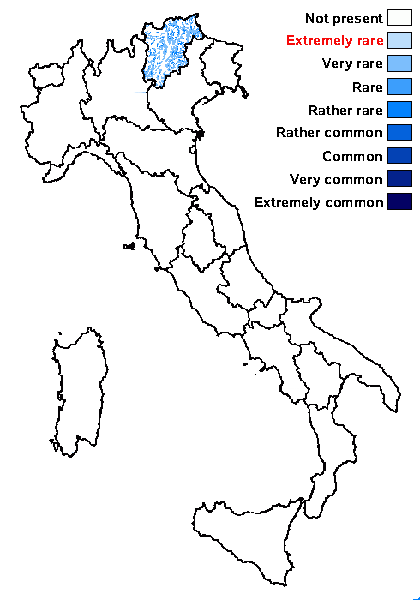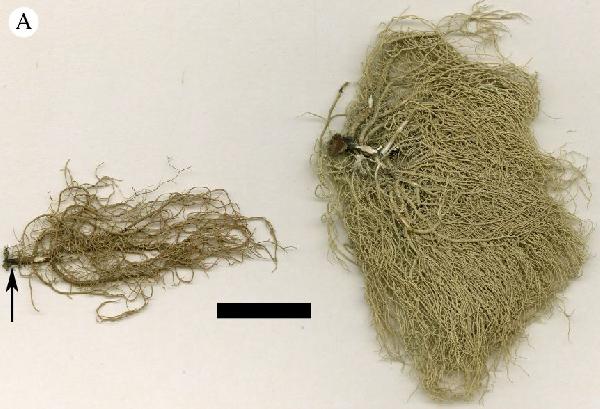Usnea viktoriana P.Clerc & Otte
Lichenologist 50: 514, 2018
Synonyms:
Distribution: N - TAA (Clerc & Otte 2018).
Description: Thallus fruticose-filamentous, greenish, shrubby to subpendulous, up to 15 cm long, anisotomic-dichotomously branching, the basal branches spreading laterally. Main branches cylindrical or slightly swollen, papillose, sometimes short and dividing quickly into secondary branches (thallus shrubby), or remaining clearly visible (thallus subpendulous); segmentation inconspicuous, with 0.6-2 mm thick annulations, the segments cylindrical or slightly swollen, the base blackened on 1-3 mm, usually thinner at the contact point with the bark and then slightly enlarging towards the main branches; lateral branches not constricted at attachment point, with or without fibrils. Foveolae, maculae, tubercles and pseudocyphellae absent; papillae always present on the main branches, numerous, short-verrucose to subcylindrical, 35-50 x 50-90 μm; fibrils few and scattered to rarely numerous on young branches. Soralia developing on the apices of thin lateral branches, punctiform when young, later forming larger, irregular, nodulose aggregates, usually even with cortex, slightly excavate when isidiomorphs are shed, with numerous isidiomorphs and fragile, often fasciculate, 0.25-0.7 mm long isidiofibrils. Cortex matt, moderately thick (6-13 % of total branch thickness); medulla dense, white, moderately thin to moderately thick (10-30.5 %); central axis white, moderately thin to moderately thick (26-62 %); ratio axis/medulla: (0.8-)1-2.8(-6.2). Apothecia rare, lecanorine, subterminal, up to 5 mm across. Asci 8-spored, Lecanora-type. Ascospores 1-celled, hyaline, ellipsoid, c. 8 x 5 µm. Photobiont chlorococcoid. Spot tests and chemistry: cortex K-, C-, KC-, P-, with usnic acid; medulla and soralia with 3 chemotypes: 1) K-, C+ and KC+ red, P-, with alectorialic acid and 5,7-dihydroxy-6-methylphthalide, 2) K+ reddish orange, C-, KC-, P-, with salazinic (main) and barbatic (accessory) acids, 3) K-, C-, KC-, P-, without lichen substances. Chemotype 1) is by far the most frequent.
Note: a recently-described species (type from South Tyrol), widespread from Central Europe to the Caucasus, with optimum in oroboreal forests.
Growth form: Fruticose filamentous
Substrata: bark
Photobiont: green algae other than Trentepohlia
Reproductive strategy: mainly asexual, by soredia, or soredia-like structures (e.g. blastidia)
Subcontinental: restricted to areas with a dry-subcontinental climate (e.g. dry Alpine valleys, parts of Mediterranean Italy)
Commonnes-rarity: (info)
Alpine belt: absent
Subalpine belt: rather rare
Oromediterranean belt: absent
Montane belt: very rare
Submediterranean belt: absent
Padanian area: absent
Humid submediterranean belt: absent
Humid mediterranean belt: absent
Dry mediterranean belt: absent

Predictive model
Growth form: Fruticose filamentous
Substrata: bark
Photobiont: green algae other than Trentepohlia
Reproductive strategy: mainly asexual, by soredia, or soredia-like structures (e.g. blastidia)
Subcontinental: restricted to areas with a dry-subcontinental climate (e.g. dry Alpine valleys, parts of Mediterranean Italy)
Commonnes-rarity: (info)
Alpine belt: absent
Subalpine belt: rather rare
Oromediterranean belt: absent
Montane belt: very rare
Submediterranean belt: absent
Padanian area: absent
Humid submediterranean belt: absent
Humid mediterranean belt: absent
Dry mediterranean belt: absent

Predictive model
 INDEX FUNGORUM
INDEX FUNGORUM
 GBIF
GBIF
 DOLICHENS
DOLICHENS


